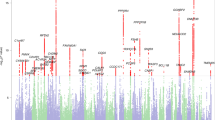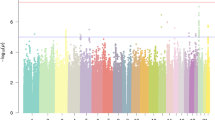Abstract
Developmental dyslexia is defined as a specific and significant impairment in reading ability that cannot be explained by deficits in intelligence, learning opportunity, motivation or sensory acuity. It is one of the most frequently diagnosed disorders in childhood, representing a major educational and social problem1. It is well established that dyslexia is a significantly heritable trait2 with a neurobiological basis3. The etiological mechanisms remain elusive, however, despite being the focus of intensive multidisciplinary research3. All attempts to map quantitative-trait loci (QTLs) influencing dyslexia susceptibility have targeted specific chromosomal regions, so that inferences regarding genetic etiology have been made on the basis of very limited information4. Here we present the first two complete QTL-based genome-wide scans for this trait, in large samples of families from the United Kingdom and United States. Using single-point analysis, linkage to marker D18S53 was independently identified as being one of the most significant results of the genome in each scan (P≤0.0004 for single word–reading ability in each family sample). Multipoint analysis gave increased evidence of 18p11.2 linkage for single-word reading, yielding top empirical P values of 0.00001 (UK) and 0.0004 (US). Measures related to phonological and orthographic processing also showed linkage at this locus. We replicated linkage to 18p11.2 in a third independent sample of families (from the UK), in which the strongest evidence came from a phoneme-awareness measure (most significant P value=0.00004). A combined analysis of all UK families confirmed that this newly discovered 18p QTL is probably a general risk factor for dyslexia, influencing several reading-related processes. This is the first report of QTL-based genome-wide scanning for a human cognitive trait.
This is a preview of subscription content, access via your institution
Access options
Subscribe to this journal
Receive 12 print issues and online access
$209.00 per year
only $17.42 per issue
Buy this article
- Purchase on Springer Link
- Instant access to full article PDF
Prices may be subject to local taxes which are calculated during checkout


Similar content being viewed by others
References
Brown, B.S. in Dyslexia: An Appraisal of Current Knowledge (eds Benton, A.L. & Pearl, D.) v–vii (Oxford University Press, Oxford, 1978).
DeFries, J.C., Fulker, D.W. & LaBuda, M.C. Evidence for a genetic aetiology in reading disability of twins. Nature 329, 537–539 (1987).
Habib, M. The neurological basis of developmental dyslexia. An overview and working hypothesis. Brain 123, 2373–2399 (2000).
Fisher, S.E. & Smith, S.D. in Dyslexia: Theory and Good Practice (ed. Fawcett, A.J.) 39–64 (Whurr, London, 2001).
Cardon, L.R. et al. Quantitative trait locus for reading disability on chromosome 6. Science 266, 276–279 (1994).
Cardon, L.R. et al. Quantitative trait locus for reading disability: correction. Science 268, 1553 (1995).
Fisher, S.E. et al. A quantitative trait locus on chromosome 6p influences different aspects of developmental dyslexia. Am. J. Hum. Genet. 64, 146–156 (1999).
Gayán, J. et al. Quantitative trait locus for specific language and reading deficits on chromosome 6p. Am. J. Hum. Genet. 64, 157–164 (1999).
Grigorenko, E.L. et al. Susceptibility loci for distinct components of developmental dyslexia on chromosomes 6 and 15. Am. J. Hum. Genet. 60, 27–39 (1997).
Field, L.L. & Kaplan, B.J. Absence of linkage of phonological coding dyslexia to chromosome 6p23–p21.3 in a large family data set. Am. J. Hum. Genet. 63, 1448–1456 (1998).
Schulte-Körne, G. et al. Evidence for linkage of spelling disability to chromosome 15. Am. J. Hum. Genet. 63, 279–282 (1998).
Morris, D.W. et al. Family-based association mapping provides evidence for a gene for reading disability on chromosome 15q. Hum. Mol. Genet. 9, 843–848 (2000).
Fagerheim, T. et al. A new gene (DYX3) for dyslexia is located on chromosome 2. J. Med. Genet. 36, 664–669 (1999).
Fisher, S.E., Stein, J.F. & Monaco, A.P. A genome-wide search strategy for identifying quantitative trait loci involved in reading and spelling disability (developmental dyslexia). Eur. Child Adolesc. Psych. 8, 47–51 (1999).
Marlow, A.J. et al. Investigation of quantitative measures related to reading disability in a large sample of sib-pairs from the UK. Behav. Genet. 31, 219–230 (2001).
Olson, R.K., Forsberg, H. & Wise, B. in The Varieties of Orthographic Knowledge Vol I: Theoretical and Developmental Issues (ed. Berninger, V.W.) 27–71 (Kluwer Academic, Dordrecht, 1994).
Gayán, J. & Olson, R.K. Genetic and environmental influences on orthographic and phonological skills in children with reading disabilities. Dev. Neuropsych. 20 487–511 (2001).
Amos, C.I. Robust variance-components approach for assessing genetic linkage in pedigrees. Am. J. Hum. Genet. 54, 535–543 (1994).
Allison, D.B. et al. Testing the robustness of the likelihood-ratio test in a variance-component quantitative-trait loci-mapping procedure. Am. J. Hum. Genet. 65, 531–544 (1999).
Lander, E. & Kruglyak, L. Genetic dissection of complex traits: guidelines for interpreting and reporting linkage results. Nature Genet. 11, 241–247 (1995).
Haseman, J.K. & Elston, R.C. The investigation of linkage between a quantitative trait and a marker locus. Behav. Genet. 2, 3–19 (1972).
Kruglyak, L. & Lander, E.S. Complete multipoint sib-pair analysis of qualitative and quantitative traits. Am. J. Hum. Genet. 57, 439–454 (1995).
Flannery, K.A., Liederman, J., Daly, L. & Schultz, J. Male prevalence for reading disability is found in a large sample of black and white children free from ascertainment bias. J. Int. Neuropsychol. Soc. 6, 433–442 (2000).
Olson, R.K., Datta, H., Gayán, J. & DeFries, J.C. in Converging Methods for Understanding Reading and Dyslexia (eds Klein, R.M. & McMullen, P.A.) 133–151 (MIT Press, Cambridge, MA, 1999).
Pennington, B.F. Using genetics to dissect cognition. Am. J. Hum. Genet. 60, 13–16 (1997).
Dib, C. et al. A comprehensive genetic map of the human genome based on 5,264 microsatellites. Nature 380, 152–154 (1996).
Pratt, S.C., Daly, M.J. & Kruglyak, L. Exact multipoint quantitative-trait linkage analysis in pedigrees by variance components. Am. J. Hum. Genet. 66, 1153–1157 (2000).
Lessem, J.M. & Cherny, S.C. DeFries–Fulker multiple regression of sibship QTL data: a SAS macro. Bioinformatics 17, 371–372 (2001).
Acknowledgements
We are very grateful to all the families who participated in this study. We thank J. Walter, P. Southcott, S. Fowler and C. Clisby for collection of the UK families; K. Taylor for assistance with handling the UK phenotype data; H. Rees, J. Smith and P. Kelley for assistance with genotyping; and D. Weeks and S. Cherny for advice on statistical analyses. Collection of the UK families and all genotyping were funded by the Wellcome Trust. The US study was supported in part by grants from the National Institute of Child Health and Human Development and the National Institute of Mental Health. L.R.C. was funded in part by an NIH grant. I.L.M is funded by the British Council and NSERC (Canada). C.F. was a Wellcome Trust Prize Student. A.P.M. is a Wellcome Trust Principal Research Fellow.
Author information
Authors and Affiliations
Corresponding author
Rights and permissions
About this article
Cite this article
Fisher, S., Francks, C., Marlow, A. et al. Independent genome-wide scans identify a chromosome 18 quantitative-trait locus influencing dyslexia. Nat Genet 30, 86–91 (2002). https://doi.org/10.1038/ng792
Received:
Accepted:
Published:
Issue Date:
DOI: https://doi.org/10.1038/ng792
This article is cited by
-
Next-generation DNA sequencing identifies novel gene variants and pathways involved in specific language impairment
Scientific Reports (2017)
-
Evaluation of ocular movements in patients with dyslexia
Annals of Dyslexia (2015)
-
Dyslexia: the Role of Vision and Visual Attention
Current Developmental Disorders Reports (2014)
-
A theoretical molecular network for dyslexia: integrating available genetic findings
Molecular Psychiatry (2011)
-
Familial Dyslexia in a Large Swedish Family: A Whole Genome Linkage Scan
Behavior Genetics (2011)



